It was just a matter of time before South African brand, Pyga Industries, delivered a marathon and stage-race specific model. And it was just a matter of time before we got to put one to the test.
By the TREAD testers
Photos: Dino Lloyd

THE BIKE
In a country that’s marathon and stage-race beflip, buying patterns follow race podium results. Well, a combination of race podium results, stock availability and sage marketing. As a result, most South African mountain bikers are riding aggressive geometry, short-travel dual-sus race bikes (usually part or full carbon). The Pyga Stage isn’t quite one of those. It has a full carbon frame and it’s dual sus, but that’s where the similarities end.
It’s got Pyga’s now much-praised single-pivot suspension design, which sees the shock (on this bike, a Rock Shox Monarch XX) floating between the upper linkage and the chainstays. This apparently allows for a better tuning of the shock rate throughout the stroke. Essentially, the link drives the shock and, being located low down, apparently allows for improved active suspension under pedalling.
The race-orientated shock offers 95mm of travel and virtually complete lockout (manual), which is a must on race bikes these days. The rear stays are designed with Pyga’s +Five concept, essentially a 5mm offset to offer a straighter chainline than that found on most bikes. According to Patrick Morewood, the Pyga designer, with the addition of 9, 10 and 11 speed cassettes (i.e, more width in the gearbox) bike frame designs didn’t change to accommodate this.
Pyga claims +Five allows for a less dished rear wheel that’s stiffer, a reduction on drivetrain wear and more efficient shifting. It’s not a brand new concept, but it’s certainly not a popular one (yet) and it does make a whole lot of sense.
The other, more noticeable, element of the Stage frame design is the fact that it can accommodate two water bottles. On a marathon/stage-race bike in South Africa, this seems to be of high significance. No need to fit an aftermarket bottle cage to the seatpost, as has become virtually the norm/bain for many racers. The second cage is on the underside of the toptube, which is rather unusual and ingenius at the same time as that’s usually wasted space on most bikes. But would it offer enough knee clearance when pedalling?
The frame is also designed with a slack 68.5-degree headtube angle and a longer-than-normal top tube. This is matched to a shorter-than-normal 70mm stem all of which bucks the trend of most marathon-specific bikes, which have more aggressive headtube angles and longer stems.
There’s a RockShox Sid XX Solo Air fork with 120mm of travel and remote lockout (that’s 20mm more travel than on most marathon/stage race bikes). The wheelset is Pyga’s own Marathon (Pyga has since created it’s own components division called DEED) carbon hoops with Maxxis Ikon tyres (our test bike had Onza Lynze rubber). There’s a SRAM X1/X01 1×11 drivetrain, SRAM Guide hydraulic disc brakes with 180/160mm rotors and Kore alloy bars (710mm), stem, seatpost and saddle.
Overall, the Stage looks sleek, low and long and the internal cable routing makes for a very clean appearance. It comes in two colour options – white and black or blue and orange.
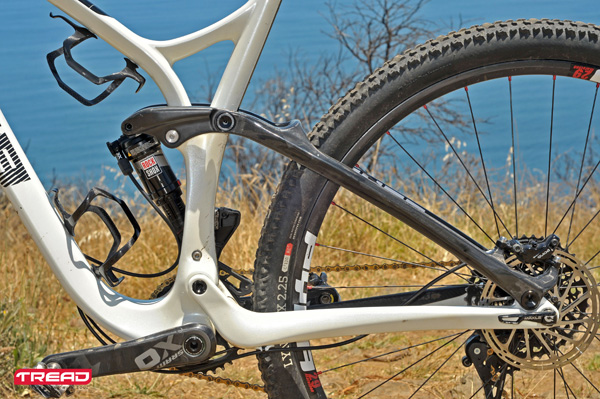
THE RIDE
Pedalling efficiency is really what should be most important on a marathon/stage-race bike. And then control and comfort not far behind.
Pedalling efficiency on the Stage was top rate. Whether riding with an open shock or in lockout, we really couldn’t find any moments where we noticed a lapse in pedalling efficiency. It climbs with agility (this is one stiff frame!) and at 11.30kg (with pedals) never felt hefty, even on very long ascents. The one area where marathon racing purists might challenge the Stage’s geometry is on steep ascents where body position needs to be well forward to successfully scale sharp ups. We specifically focussed on this kind of climb and did have to be more active in getting our body forward on very steep ascents (and particularly switchback climbs), but can’t say we ever felt inadequate.
While we never sensed it in our pedalling action, we could see a better chain line throughout the 11 gears and that can only be a good thing, courtesy of Pyga’s +Five design concept.
The most obvious benefit we felt, right from the first ride, was the ‘long and low’ geometry. It was really comfortable on flat roads or slight gradients and an exceptionally stable descender. In fact we felt as courageous as on a bigger travel, more robust trail bike when hitting rough descents ‘blind’.
With a little more rubber out front than most marathon bikes, you do feel more in control, both on descents and very fast turns. And the suspension was superb. Unlike some marathon/stage-race bikes where you feel the rear shock’s limits on bigger, unexpected hits, the Stage never really made us feel like we’d erred or been too ambitious. And we did challenge it properly in this department.
What about the knee clearance on the toptube bottle? Well, there’s no issue really. Not when pedalling on a predictable surface or gradient. We did brush it occasionally on a technical descent, but then that’s to be expected and doesn’t actually affect your pedalling efficiency, which, as we mentioned in the first sentence, is the real priority on a marathon/stage-race bike.
Shifting was crisp and braking was good, making the SRAM components a good choice for the Stage, while the Kore cockpit parts all seemed reliable and robust, although you could trim weight by replacing these with carbon-based parts if you wanted to.
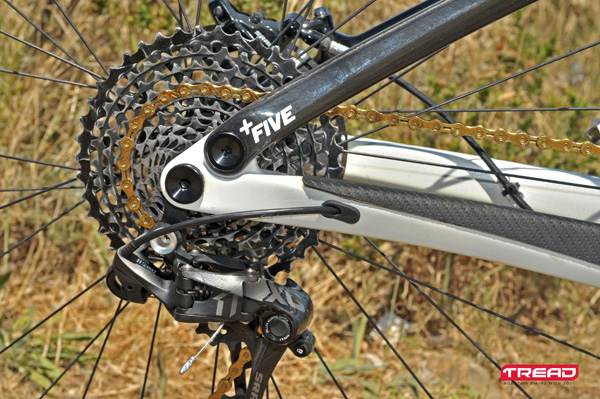
THE VERDICT
At this price, the Stage offers exceptional value for money. You’re getting a full carbon, dual sus bike, with carbon rims and high-level spec… Yes, it has a manual adjust rear shock, which may seem a little ‘last generation’ as more and more top-end race bikes come with fully remote or intuitive suspension adjustment. But to be honest, it’s a small thing that saves a fair bit on the price of the bike. With two bottle cages and high levels of both comfort and control, the Stage is blurring the dividing line between marathon/stage-racer and trail-tamer. The average South African marathon/stage racer is under-skilled, super-fit, highly ambitious, value-wary and proudly South African. All of these boxes are boldly ticked with the Stage. We expect to see it feature on the Cape Epic’s top-10 most popular brands in 2017, if not sooner. And on some podiums too.
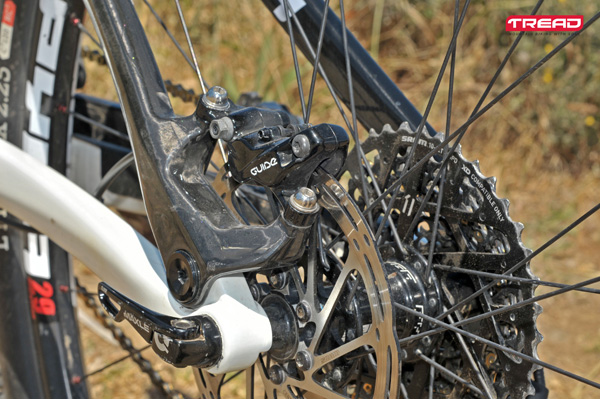
PYGA SAYS
With our slack and long geometry we have lengthened the reach and slackened the head angle of the Stage frame. This allows for a shorter stem and wider bars to be fitted, improving stability and technical handling compared with conventional marathon bikes. This new twist on marathon geometry gives the bike maximum stability at speed, during cornering and on steep technical descents. The finely balanced leverage ratio and anti squat characteristics of the suspension system offer a compliant feel with minimal energy loss while pedalling and allows the bike to climb among the best in its class.
The +FIVE chain line is another improvement we offer you, which shifts the rear end of the frame 5mm towards the drive side and changes the chain line from 49mm to 44mm – something that, until now, has not changed since the days of 7-speed cassettes. Additionally this addresses the uneven rear wheel dish, improving wheel strength and stiffness. Simply put, the chain line on the 11th gear (easiest gear, largest cog) on a +FIVE frame is equivalent to the chain line on the 9th gear of a regular frame – reducing wear and improving shifting performance.
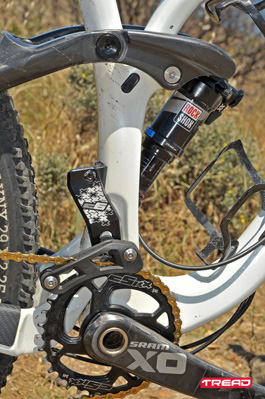
GEOMETRY
SIZES: M (tested), L, XL
TOPTUBE LENGTH: 622mm
SEATTUBE LENGTH: 480mm
HEADTUBE ANGLE: 68.5 degrees
SEATTUBE ANGLE: 75 degrees
CHAINSTAY LENGTH: 440mm
WHEELBASE: 1175mm
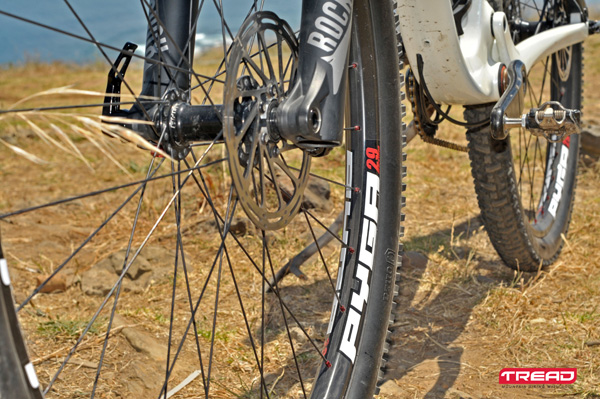
*SPECS
PRICE: R73700
COLOURS: Bright orange on blue, Covert black on white
FRAME: Toray High Modular Carbon
WEIGHT: 11.30Kg (incl pedals)
FORK: RockShox Sid XX Solo Air with 120mm of travel and remote lockout
SHOCK: RockShox Monarch XX with 95mm of travel
SHIFTERS: SRAM X1
FRONT DERAILLER: N/A
REAR DERAILLER: SRAM X01
CRANKSET: SRAM X1 (32T)
BRAKESET: SRAM Guide RS, SRAM Centerline Rotors (180/160mm)
WHEELS: Pyga 29 Marathon Carbon
TYRES: Maxxis Ikon 2.2 Tubeless (Tested – Onza Lynz 2.25)
OTHERS: Kore OCD Alloy Seatpost, Kore Aerox Alloy Handlebars (710mm), Kore Aerox Alloy Stem (70mm), Kore Durox Saddle, Cane Creek Tapered.
CONTACT: www.pygaindustries.com
XC-MARATHON-TRAIL-FREERIDE
RECREATIONAL-COMMITTED-PERFORMANCE
TREAD Magazine is sold throughout South Africa and can be found in: Spar, CNA, Exclusive Books, Discerning bike shops and on Zinio
*Originally published in TREAD Issue 38, 2015 – All rights reserved

.


